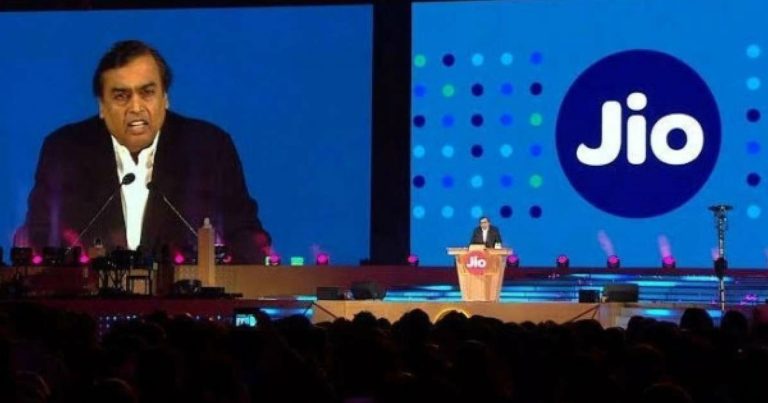After several months of successful testing, the registration for Jio GigaFiber has kicked off.
Under this ‘fiber-to-the-home’ service, Reliance Jio will provide broadband, IPTV, virtual reality gaming, and landline phone service with the help of its fiber-optic network. The company is expected to launch its services in cities and areas from where it has received maximum registration requests. As per sources, even the basic plan is set to offer 100 GB data with 100 MBPS speed for just Rs. 500 per month.
Currently, service providers like BSNL, Airtel, Hathway, Vodafone, Tata Communications, and DEN Broadband have a nationwide presence in India. Tata Communications has recently launched its second brand “Tata Sky Broadband” and is registering new customers in certain cities. At present, only BSNL offers service in most parts of country’s rural areas as these are considered low ARPU (average revenue per user) areas. But, Jio plans to change the scene with its optic fiber network installation in India’s rural areas as well.
The company has already started working on developing its infrastructure in various Indian cities. Jio has also purchased mobile towers, spectrum, and fiber optic assets from RCom recently. However, the rollout won’t be as easy as rolling out of 4G mobile network due to the complex ‘last mile connectivity’ issues.
Even existing big ISP companies are finding it difficult to get permissions from municipalities, housing societies to install their cables at various places. Making a considerable amount of profits is a distinct dream. Perhaps, this is the reason Jio has shown the willingness to tie-up with Multi System Operators (MSO) and Local Cable Operators (LCO) to offer its services.
Are local operators better equipped to deal with customers’ problems?
In India, there are around 125,000 LCOs (Local Cable Operators) with an average 25 kilometers of the fiber under each operator’s control. These operators employ lakhs of employees in every state.
At one point, services offered by cable operators were considered unreliable. That tag is gone with the end of analog services. These days, operators provide digital cable TV services at half the price charged by DTH operators in some areas.
You can get all channels package for around Rs. 250 to Rs. 450 per month against an average of Rs. 550 per month charged by DTH operators. In case of any repairs, DTH operators ask customers to pay additional charges even for technician’s visit. Cable operators offer maintenance and repairs for free to the customers.
Local Cable Operators work as franchisees for small ISPs and cater to 500 to 1000 customers located in their service areas. Their staff members, technicians, are locals and know the area as well as customers personally in most cases. So just a phone call or a visit to the local operator’s office can help in getting the issue resolved.
On the other hand, most of the big ISPs have a common complaints number for registering customers’ complaints. Call center executives request the callers to follow a few troubleshooting steps as a formality and then file a complaint if the problem is not resolved. These complaints are forwarded to the concerned city office which sends a technician within 24 to 48 hours from registering the issue. Big ISPs take more time to resolve the customer’s concern compared to the time taken by LCOs. Local operators have a limited number of customers, so, complaints management also becomes lesser complicated. You can expect the operator to solve the issue on the same working day.
Everyone depends on the broadband in our daily routine these days and waiting for 24 to 48 hours for the technician to arrive after registering the complaint can be painful. People end up making 2 to 3 calls to the big player’s customer service and often need to repeat their concern multiple times.
Small ISPs maintain the quality of their network as they are under threat of losing their business to bigger rivals. They offer high bandwidth, and system consists of mostly fiber optic lines (ADSL from roof-top to the customer’s house in some cases). But, larger ISPs take short-cuts on maintenance as they have a lesser fear of losing customers.
A common perception is that big ISPs are in a better position to protect and maintain their fiber-optic network. But posts and reviews written by their frustrated customers tell a different story. Building-to-building fiber lines often get damaged or even get stolen, cut off by miscreants. Local cable operators complete the police procedures and replace broken cables within a day. But, big ISPs take multiple days for the same task due to complicated procedures including inspection by various officials for reinstalling fiber lines.
LCOs offer prepaid broadband service
Most of the local players offer prepaid broadband connections with unlimited plans. The customer has to recharge the account on the due date every month. Small internet service providers allow their franchise holders to design and sell area specific plans. Local operators create plans according to the needs of local subscribers. At present, you can easily find LCOs offering 100 GB data with 50 MBPS speed at Rs. 700 per month (prepaid plan).
On the other hand, most of the big ISPs use the postpaid model in which customers are sent a monthly bill with price plan charges and GST. Big players have a limited set of prepaid plans for customers living in a particular city. They cannot negotiate prices or create an arrangement according to the customer’s needs, like a local cable operator.
As pointed out by industry experts, wired broadband’s penetration is just around six percent in India while it remains 60 percent in other developing countries. Thus, there is a lot of room for multiple players. Fortunately, companies like DEN and Jio are willing to approach customers even with low APRU plans, as low as Rs. 500 per month.
If these companies join hands with LCOs who already have the last mile connectivity with fiber networks, it would be a win-win situation for both. LCOs will get new business, while operators like Jio would be able to offer their services to people living inside narrow lanes in single floor houses located across various corners of the city.
Further, Read More:
Why opting for a postpaid connection does not make sense anymore?
The Undersea Cables tell how the global connectivity comes to your doors



